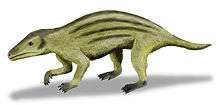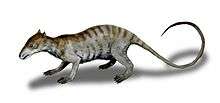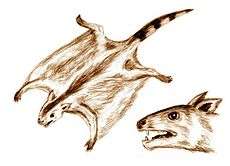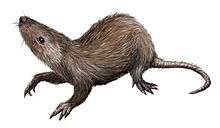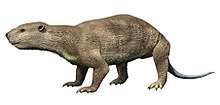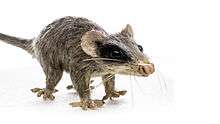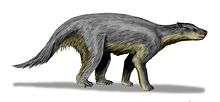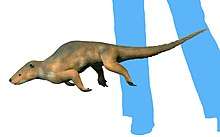Nemegtbaatar
Nemegtbaatar is a genus of mammal from the Upper Cretaceous Period of what is now Mongolia. It existed in the company of much larger dinosaurs, found together in the Nemegt Basin. This creature was a member of the extinct order Multituberculata. It is within the suborder Cimolodonta and is a member of the superfamily Djadochtatherioidea. It was a hopping, gerboa-like species.[1]

| Nemegtbaatar | |
|---|---|
 | |
| Reconstructed skull | |
| Scientific classification | |
| Kingdom: | Animalia |
| Phylum: | Chordata |
| Class: | Mammalia |
| Order: | †Multituberculata |
| Superfamily: | †Djadochtatherioidea |
| Genus: | †Nemegtbaatar |
| Species: | †N. gobiensis |
| Binomial name | |
| †Nemegtbaatar gobiensis Kielan-Jaworowska Z., 1974 | |
The genus Nemegtbaatar (Kielan-Jaworowska Z., 1974) is known by the species Nemegtbaatar gobiensis found in the Santonian to Campanian (Upper Cretaceous) Barun Goyot Formation of Mongolia. "Compared to all extant mammals, the braincase in Nemegtbaatar and Chulsanbaatar is primitive." (Hurum, 1998). "All extant mammals" includes monotremes, such as the duck-billed platypus, despite its residual egg-laying habit.
Nemegtbaatar was a relatively large member of Djadochtatherioidea, with a skull length of up to 4.5 centimetres (1.8 in). At least one specimen is in the Institute of Paleobiology collection of the Polish Academy of Science at Warsaw, (ZPAL MgM-1/76).
References
- Meng Chen, Gregory Philip Wilson, A multivariate approach to infer locomotor modes in Mesozoic mammals, Article in Paleobiology 41(02) · February 2015 DOI: 10.1017/pab.2014.14
Further reading
- The abstract of Hurum (1998), The braincase of two Late Cretaceous Asian multituberculates studied by serial sections. Acta Palaeontologica Polonica 43(1), p 21-52.
- Kielan-Jaworowska (1974), Multituberculate succession in the Late Cretaceous of the Gobi Desert (Mongolia). Palaeontologica Polonica, 30, p. 23-44.
- Kielan-Jaworowska Z & Hurum JH (2001), "Phylogeny and Systematics of multituberculate mammals." Paleontology 44, p. 389-429.
- Much of this information has been derived from MESOZOIC MAMMALS; Djadochtatherioidea, an Internet directory.

